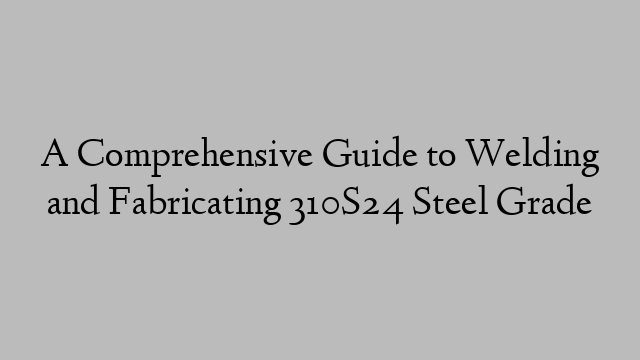Address
304 North Cardinal St.
Dorchester Center, MA 02124
Work Hours
Monday to Friday: 7AM - 7PM
Weekend: 10AM - 5PM
Address
304 North Cardinal St.
Dorchester Center, MA 02124
Work Hours
Monday to Friday: 7AM - 7PM
Weekend: 10AM - 5PM

Welding and fabricating 310S24 steel grade can be a challenging task, but with the right knowledge and techniques, it can be done successfully. 310S24 is a high-temperature resisting grade of stainless steel that is commonly used in the production of industrial furnaces, heat treatment equipment, and other high-temperature applications. In this comprehensive guide, we will explore the properties of 310S24 steel grade, the welding and fabricating techniques, and the best practices to achieve a high-quality weld.
Properties of 310S24 Steel Grade
310S24 is an austenitic stainless steel grade that contains high levels of chromium and nickel, making it highly resistant to oxidation and corrosion at high temperatures. It has good mechanical properties, high heat resistance, and excellent weldability. The steel grade is also known for its high strength, toughness, and ability to withstand extreme temperatures and thermal shock.
Welding Techniques for 310S24 Steel Grade
When welding 310S24 steel grade, it is important to use the right welding techniques to ensure a strong and durable weld. Some of the common welding techniques used for 310S24 steel grade include:
1. Gas Shielded Arc Welding (GMAW/MIG): This method uses a continuous solid wire electrode and a shielding gas to protect the weld from atmospheric contamination. It is a popular method for welding 310S24 steel grade due to its high welding speed and ease of use.
2. Tungsten Inert Gas Welding (GTAW/TIG): This method uses a non-consumable tungsten electrode to create the weld and a separate filler material. It is a precise welding technique that produces high-quality welds, making it suitable for welding thin sections of 310S24 steel grade.
3. Shielded Metal Arc Welding (SMAW): This method uses a consumable electrode coated with flux to create the weld. It is a versatile and economical welding technique that can be used for welding 310S24 steel grade in various positions.
Fabricating Techniques for 310S24 Steel Grade
In addition to welding, fabricating 310S24 steel grade also requires the use of the right techniques to achieve the desired shape and finish. Some of the common fabricating techniques used for 310S24 steel grade include:
1. Cold Forming: 310S24 steel grade can be cold formed to create a variety of shapes and sizes. However, it is important to use the right type of equipment and tools to avoid work hardening and cracking.
2. Machining: Machining is a process used to remove material from 310S24 steel grade to create a specific shape or finish. It is important to use the right cutting tools and machining parameters to achieve a high-quality finish.
Best Practices for Welding and Fabricating 310S24 Steel Grade
To achieve high-quality welds and fabrications with 310S24 steel grade, it is important to follow some best practices, including:
– Using the right welding and fabricating techniques for the specific application
– Preheating the steel to reduce thermal stress and prevent cracking
– Using suitable filler materials and consumables that are compatible with 310S24 steel grade
– Using the correct welding parameters, such as current, voltage, and travel speed, to achieve a strong and durable weld
– Ensuring proper ventilation and using personal protective equipment when welding or fabricating 310S24 steel grade
– Conducting thorough inspections and non-destructive testing to ensure the integrity of the welds and fabrications
In conclusion, welding and fabricating 310S24 steel grade requires the use of the right techniques, tools, and best practices to achieve high-quality results. By understanding the properties of 310S24 steel grade and following the recommended welding and fabricating techniques, it is possible to produce strong, durable, and high-temperature resistant welds and fabrications. Always consult with a qualified welding engineer or metallurgist for specific recommendations when working with 310S24 steel grade.